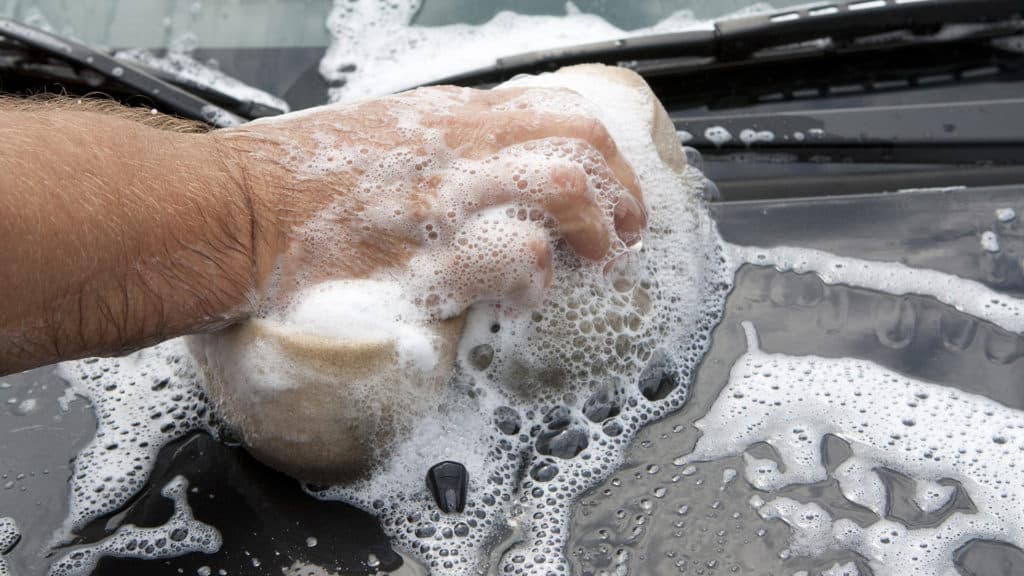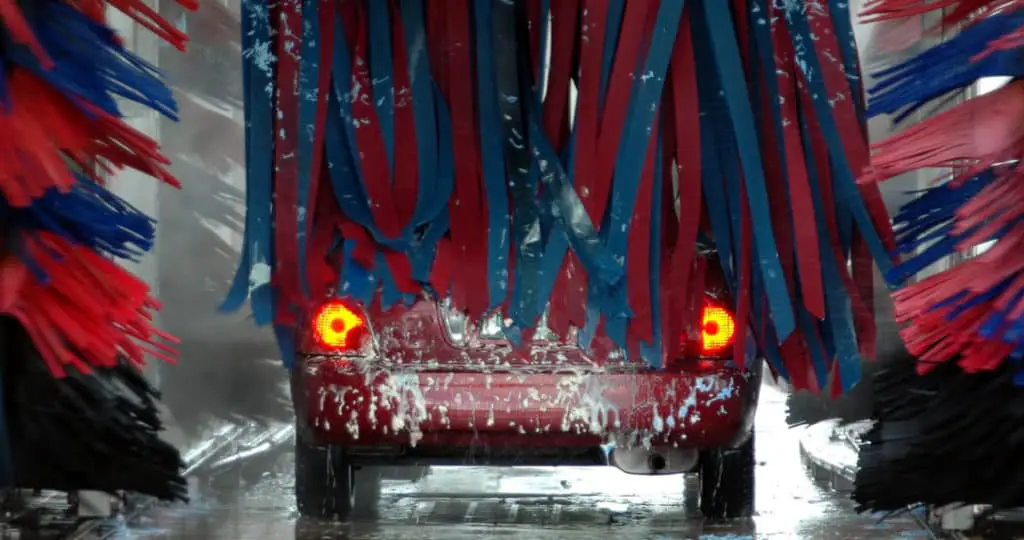- What Is The Two Bucket Car Wash Method (Beginners Guide) - July 2, 2021
- Will Washing Car Remove Wax? What You Need To Know - December 3, 2019
- What Causes Scratches On Car Paint: You Should Know This - April 29, 2019
Last Updated on March 19, 2025 by Nate Schnell
Everyone washes their car, but are you sure you’re doing it the right way? Surprisingly, many people unintentionally cause damage to their vehicle every time they wash it. The goal of washing your car is to clean and protect it, but improper washing techniques can lead to scratches, swirl marks, faded paint, and eventually rust. In this guide, I’ll share practical, actionable insights from over a decade of experience in car detailing to help you wash your car safely and effectively—keeping it looking its best for years to come.
Why the Two-Bucket Method is the Gold Standard
When it comes to washing your car, the method you choose directly impacts the paint condition over time. The two-bucket method stands out because it drastically reduces the risk of scratching your paint. Scratches typically happen when dirt and debris get caught in your sponge or cloth, creating tiny abrasions on the paint surface. Over time, these tiny scratches dull your vehicle’s shine and invite corrosion.
To prevent this, you’ll use two buckets—one containing your car wash solution (water mixed with specialized car wash soap), and another filled only with clean water for rinsing. As you clean each section, rinse your sponge in the second bucket. Doing so removes any grit or dirt particles, preventing them from being dragged across the paint and causing damage. If your rinse bucket gets dirty midway through, don’t hesitate to dump and refill it with fresh water. Keeping your rinse bucket clean throughout the process is essential.
Choosing the Right Tools and Products for Safe Car Washing
Before you begin washing, gather your essentials. Using quality products makes a significant difference in both results and safety for your vehicle’s paint:
- Specialized Car Wash Soap: Always choose a dedicated car wash soap designed specifically for automotive paint. Avoid dish soap or household detergents—they can strip protective wax and oils from your paint, causing premature fading and increased vulnerability to scratches.
- Microfiber Sponge or Mitt: Microfiber is gentle on your car’s finish yet highly effective at lifting away dirt. It traps dirt particles deep within its fibers, preventing them from scratching your car’s surface.
- Wheel Brush (Optional): Wheels accumulate brake dust, grime, and debris that can be difficult to remove. A soft-bristle wheel brush designed specifically for automotive use helps clean wheels efficiently without scratching their finish.
- Two Large Buckets: Clearly designate one bucket for your soapy wash solution and the other strictly for clean rinsing water, as outlined earlier.
- Hose or Pressure Washer: A gentle water stream is perfect for rinsing the car thoroughly. A pressure washer can also be useful, provided you follow careful guidelines to avoid damage (covered later in this guide).
Step-by-Step Guide to Hand Washing Your Car Correctly
Washing your car by hand remains the safest, most effective method for keeping your paint in optimal condition. Follow these straightforward steps:
Begin by thoroughly rinsing your vehicle to remove loose dirt and dust. Pay special attention to the undercarriage if you live in an area with salted roads during winter months. This pre-rinse removes abrasive dirt particles and prepares your car for safer cleaning.
Starting from the top of your vehicle and working downward, gently wash each section using your microfiber sponge soaked in your car wash solution. Avoid circular scrubbing motions, as they can create swirl marks. Instead, use straight lines either horizontally or vertically for safer, scratch-free cleaning.
After washing each section, rinse your sponge thoroughly in the second bucket filled with clean water. This practice removes abrasive debris that could otherwise harm your paint finish. Flip the sponge or mitt regularly to use cleaner surfaces for the lower, dirtier parts of the car, minimizing risks further.
Once you’ve finished washing the painted surfaces, clean your wheels and tires last, using a separate sponge or brush reserved exclusively for these areas. Wheels often have abrasive brake dust that should never touch the car’s delicate paintwork.
Lastly, rinse your entire vehicle carefully from top to bottom with clean water, removing all soap residues. Leaving soap on the paint can cause unsightly water spots.
Pressure Washer Car Washing: Faster but Proceed with Caution
If hand washing seems too time-consuming, pressure washing is an appealing alternative. However, it’s essential to follow careful guidelines to avoid accidentally damaging your vehicle:
Begin by rinsing your car from a safe distance (about three feet away), using low-pressure water to loosen dirt gently. Never spray too close, as intense water pressure can chip paint or damage rubber seals.
Apply car-specific soap using the pressure washer’s detergent attachment or a foam cannon accessory. Allow the soap to dwell briefly—never letting it dry completely—to break down dirt efficiently.
Thoroughly rinse the car again, keeping your nozzle at least one foot away from the surface. Move steadily and deliberately, ensuring soap and dirt are fully rinsed from all surfaces. Pay extra attention to crevices, wheel wells, and undersides, as soap tends to accumulate in these hidden spots.
Understanding Car Wash Soap: Why it Matters
Using the wrong soap on your vehicle is one of the quickest ways to unintentionally harm your paint. Household products like dish soap contain harsh detergents designed to cut grease aggressively. These ingredients strip protective wax and essential oils from your paint, leaving it exposed and vulnerable.
Instead, choose high-quality, car-specific wash products. Trusted brands like Meguiar’s Gold Class Car Wash offer reliable cleaning power without damaging your vehicle’s protective layers. Another popular option is wash-and-wax combination soaps, which add a thin protective coating while you wash. However, these shouldn’t completely replace periodic traditional waxing, which provides superior long-term protection.
Additional Tips for Safer, Easier Car Cleaning
Proper car care is more than just the right washing method. Keep these key tips in mind to maintain your vehicle’s finish effortlessly:
- Separate Your Towels: Keep dedicated towels or mitts exclusively for wheels and tires to avoid cross-contamination. Brake dust particles are highly abrasive, and towels used on wheels should never touch painted surfaces.
- Handle Stubborn Spots with Care: If you encounter difficult stains or stuck-on debris, resist the urge to scrub aggressively. Instead, apply a bit of WD-40 to safely loosen debris first, then gently wipe it away. Harsh scrubbing can irreversibly damage your car’s clear coat.
- Drying Matters: Dry your car thoroughly using clean microfiber towels designed specifically for drying vehicles. Allowing water to evaporate naturally often leaves water spots or streaks, which can become difficult to remove later.
- Wax Regularly: Regular waxing (every three to six months) provides essential protection against the elements, UV rays, and contaminants. Waxing also maintains the shine and clarity of your paint finish, ultimately extending its lifespan and appearance.
Final Thoughts on Proper Car Washing
Taking the time to wash your car the right way isn’t merely about aesthetics. Proper washing methods safeguard your investment, protect against corrosion and fading, and help preserve your vehicle’s resale value. By implementing the two-bucket method, using the right tools and products, and being mindful of common pitfalls, you’ll keep your vehicle looking pristine for years. Regular, attentive care is the best way to enjoy a clean, vibrant, and beautiful car—without accidentally harming it in the process.
To further expand your car care knowledge, you may want to explore these authoritative resources:
Washing your car correctly is one small habit that can dramatically enhance its appearance and longevity. Enjoy the satisfaction of a job well done, knowing you’re protecting your valuable asset each time you clean it.



